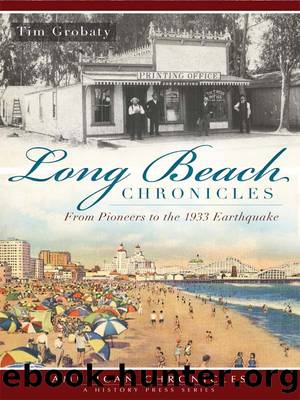Long Beach Chronicles by Tim Grobaty

Author:Tim Grobaty
Language: eng
Format: epub
Publisher: Arcadia Publishing Inc.
Published: 2012-08-14T16:00:00+00:00
Even before the advent of the automobile, parking was a problem in Long Beach. People venturing into town, or even just camping on the beach, parked their horses and wagons on the strand in 1884.
CARS HIT THE STREETS
Long Beach wasn’t even old enough in 1902 to apply for a driver’s license when E.R. Brown’s car wheezed down the road, scattering children and making horses bolt in wide-eyed terror.
Brown, a Pine Avenue jeweler and early bandleader, was one of the first car owners in the fourteen-year-old village. It took him and his son two years to build the steam-powered vehicle, and it was the talk of the town as amazed strollers watched the Brown boys speed up and down Pine Avenue—at top speeds of fifteen miles per hour.
By year’s end, the Long Beach automobile fleet would grow to three. Harry Hamilton, a real estate broker, was the next to move into the future with this ultimate toy. He bought a White Steamer in 1902. Another local man, William Varney, who would later go into the car repair business, also bought a car—a Stanhope Steamer—that year.
Naturally, it wasn’t long before everyone had to have one. The early car owners were the big shots in town, and most of them purchased the hugely successful Ford automobiles. Early in 1904, a record of thirty-one car sales was made by the first Ford Agency in Long Beach. Bank owners and civic leaders snatched the cars up: C.J. Walker, P.E. Hatch, Charles Heartwell and C.J. Daugherty.
By 1907, only five years after the first trio of steamers had rattled down the Long Beach boulevards, a count showed that there were between four and five hundred automobiles in Long Beach.
And there were six garages caring for the hundreds of Long Beach automobiles, which, according to one chronicler of the era, “every day or less have something the matter with them.”
With the advent of the auto came laws restricting their speed in town. The first speed limits set twenty miles per hour as the fastest anyone was allowed to travel anywhere. In the so-called congested district, between Maine and Alamitos Avenues and south of Seventh Street, the limit was fifteen milers per hour and ten miles per hour when “passing a school, approaching an intersection and going around a corner or curve.”
As always, laws had to be passed to prevent the actions of dense drivers. Enough people left their cars unattended on railroad tracks that a law had to be passed barring that.
A “visible or audible” signal was required when making a turn. The signal could be made by holding out a hand or by “one blast of the horn.”
It was also unlawful to drive between one hour after sunset and one hour before sunrise without a lamp showing white light toward the front and red toward the rear.
Inevitably, fender benders came to Long Beach. For the most part, the scattered drivers managed to avoid one another, but with increased traffic around Christmastime in 1905, P.E. Hatch, then cashier of the National Bank of Long Beach, was involved in an accident with Jotham Bixby Jr.
Download
This site does not store any files on its server. We only index and link to content provided by other sites. Please contact the content providers to delete copyright contents if any and email us, we'll remove relevant links or contents immediately.
| Africa | Americas |
| Arctic & Antarctica | Asia |
| Australia & Oceania | Europe |
| Middle East | Russia |
| United States | World |
| Ancient Civilizations | Military |
| Historical Study & Educational Resources |
The Dawn of Everything by David Graeber & David Wengrow(1654)
The Bomber Mafia by Malcolm Gladwell(1583)
Facing the Mountain by Daniel James Brown(1504)
Submerged Prehistory by Benjamin Jonathan; & Clive Bonsall & Catriona Pickard & Anders Fischer(1420)
Wandering in Strange Lands by Morgan Jerkins(1374)
Tip Top by Bill James(1351)
Driving While Brown: Sheriff Joe Arpaio Versus the Latino Resistance by Terry Greene Sterling & Jude Joffe-Block(1339)
Evil Geniuses: The Unmaking of America: A Recent History by Kurt Andersen(1320)
Red Roulette : An Insider's Story of Wealth, Power, Corruption, and Vengeance in Today's China (9781982156176) by Shum Desmond(1315)
The Way of Fire and Ice: The Living Tradition of Norse Paganism by Ryan Smith(1305)
American Kompromat by Craig Unger(1271)
It Was All a Lie by Stuart Stevens;(1265)
F*cking History by The Captain(1254)
American Dreams by Unknown(1237)
Evil Geniuses by Kurt Andersen(1225)
Treasure Islands: Tax Havens and the Men who Stole the World by Nicholas Shaxson(1222)
White House Inc. by Dan Alexander(1179)
The First Conspiracy by Brad Meltzer & Josh Mensch(1140)
The Fifteen Biggest Lies about the Economy: And Everything Else the Right Doesn't Want You to Know about Taxes, Jobs, and Corporate America by Joshua Holland(1092)
